Cleaning and Removing Stains From Ceiling Tiles
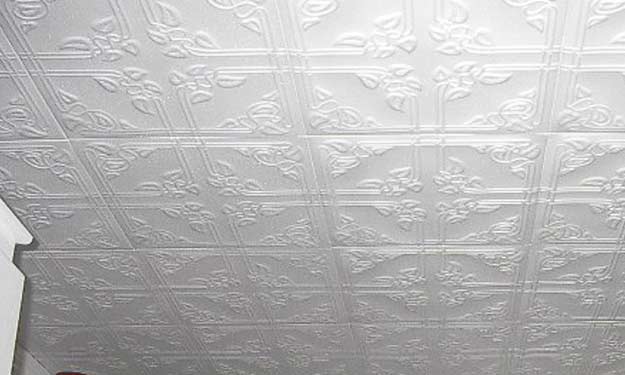
How To Clean and Remove Stains From Ceiling Tiles
When I first told my friends and family that I was planning on installing ceiling tiles in my new home, the most common response was “why?”
Well, let me tell you, ceiling tiles today aren’t your garden-variety, plain, white, square “popcorn” tiles in the basement or office anymore.
No, the possibilities are endless when it comes to ceiling tiles…there are a wide variety of materials, designs and colors to choose from.
When I went to my local home improvement store, I saw tiles that were made to look like wood planks, real silver, tin, copper and even leather. The surfaces were textured, raised, smooth and ornately styled.
In fact, I had some difficulty choosing due to the large selection available, so I ended up going home with both faux wood and silver ceiling tiles. Everyone was surprised when they saw how modern my home looked with the beautiful ceiling tiles, so I know that they were a great investment.
Fast forward a year and a half later and the ceiling tiles are looking…a little dingy, to say the least.
That won’t do at Mrs. Clean’s home! (What would the neighbors say?) So I pulled out the ceiling tile manufacturers instructions and they say that the tiles will need regular cleaning to keep them looking as beautiful as when they were first installed.
The method you use to clean ceiling tiles or panels depends solely on the material it is made from; whether it is porous or sealed, and the texture, if any. If the ceiling tile was already installed when you moved in, or you’re not sure which type of ceiling tile you have, you can make a visual assessment based on the texture to safely clean the ceiling.
So, if you’re just a little behind in the in the ceiling-tile-upkeep-department, or you just installed ceiling tiles and want to know the proper methods for cleaning them, then look no further.
I’ve tested out these methods and have even checked with the experts, so you can be rest assured that these tips will get your tiles looking like new again.
Porous Ceiling Tiles
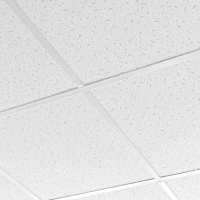 These tiles are a type of acoustic (sound-absorbing) tile found in most commercial buildings. They are also found in many older homes. Porous tiles are not sealed.
These tiles are a type of acoustic (sound-absorbing) tile found in most commercial buildings. They are also found in many older homes. Porous tiles are not sealed.
Cleaning
Porous ceiling tiles are difficult to clean because they are made of a fibrous material with holes in them. Routine dusting or vacuuming with a soft brush attachment will prevent cobwebs, dirt and stains from marring the ceiling. If stains have formed the tiles usually require replacing.
- Throw a drop cloth over furniture and floors to save you from having to clean the whole room afterward.
- Wear protective eye wear to keep dust and particles from causing serious damage.
- If you haven’t dusted the ceiling in a long period of time, use a dust mask to prevent inhalation of dust and dirt.
- Dust with a feather duster or quality static duster, paying special attention to corners and cobwebs (cheaper static dusters can become snagged and leave little hairs behind).
- Disposable dusting cloths should not be used – they can snag on porous ceiling tiles and actually make the tiles dirtier by grinding in dust, dirt, and cobwebs.
- A soft brush or dusting attachment on vacuum cleaners works well to suck up particles that would be airborne with regular dusting.
- Be sure to be gentle so you don’t push the dirt into the open holes in the tiles.
Removing Stains
If there are spots, dirt, or stains that you notice after dusting, attack them with a dry sponge, available through most janitorial suppliers. This is a rubber sponge that is usually very effective in places where you can’t (or shouldn’t) use water.
If you can’t remove a stain, you’ll probably have to replace a tile. Luckily, the porous type of tiles are usually inexpensive to replace.
Non Porous/Sealed White or Colored Ceiling Tiles
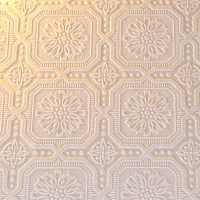 These tiles are sealed and are really beautiful, usually with intricate designs, like the painted white ceiling tile that is pictured above.
These tiles are sealed and are really beautiful, usually with intricate designs, like the painted white ceiling tile that is pictured above.
Cleaning
Your only regular “cleaning” task will be a light dusting once a month (or every other month) with this simple process:
- They should be dusted, as necessary with a soft, cotton dust mop, feather duster, or static duster.
- Disposable dusting sheets can sometimes scratch the finish, so don’t use them.
- When these ceiling tiles appear dull or dirty, use a mild solution of 1 TBL dish washing liquid to 1 gallon of warm water and wipe gently with a soft cloth.
- Dry the tile completely with a clean terry cloth to restore a high shine and avoid streaks.
Removing Stains
Sealed ceiling tiles are non-porous which means if you splatter something on the ceiling it will be easily removed with just the mild dish washing liquid and water solution. You should not have to worry about stains.
Tin, Silver, Copper or Wood Finished Ceiling Tiles
 These ceiling tiles can have facings that are made of things like vinyl or PVC, but they have beautiful finishes that look like metal, plaster, or even decorative wood surfaces with detailed, raised designs. These surfaces are usually waterproof and very easy to clean.
These ceiling tiles can have facings that are made of things like vinyl or PVC, but they have beautiful finishes that look like metal, plaster, or even decorative wood surfaces with detailed, raised designs. These surfaces are usually waterproof and very easy to clean.
Cleaning
- Dust with a dust mop, feather duster, or static duster.
- Clean one tile at a time. Using a towel to clean, a towel to rinse, and a towel to dry.
- Clean with a soft cotton towel and wipe gently with a mild cleaning solution of 1 TBL dish washing liquid to 1 gallon of warm water.
- Rinse the tile completely using a second clean damp rag.
- Dry the tile completely with a clean terry cloth to restore a high shine and avoid streaking.
Tin tiles don’t usually rust, but if you see signs of rust, you can gently remove the rust with very fine grade steel wool.
Popcorn Textured Ceiling Tiles or Panels
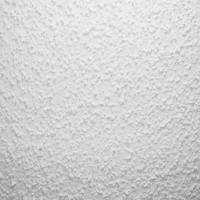 These ceiling tiles or panels are simply wallboard or sheet rock that has been either vinyl coated or just painted. The tiles can sometimes be sprayed with popcorn surfacing. Care for these tiles is basically the same as for a normal ceiling unless they contain asbestos.
These ceiling tiles or panels are simply wallboard or sheet rock that has been either vinyl coated or just painted. The tiles can sometimes be sprayed with popcorn surfacing. Care for these tiles is basically the same as for a normal ceiling unless they contain asbestos.
CAUTION: Popcorn ceilings prior to the late 1980’s actually contained asbestos. If you have a popcorn ceiling the only way to know for sure if it contains asbestos is to have it tested by a professional lab. For your safety, have it tested before attempting to clean it yourself as you will knock off the popcorn and release the asbestos fibers into the air.
Cleaning
- Dust regularly for cobwebs and dirt with a feather duster, static duster, or vacuum attachment.
- Cleaning these tiles can be difficult unless there is vinyl coating or enamel paint.
- You should gently use a dry sponge when it’s a surface you should not get wet.
Stain Removal
Stains on popcorn ceilings are really difficult to remove. If painting the ceiling to cover the stain is not an option, you can try hydrogen peroxide to lighten the stain. Avoid saturating the stain as this can cause the “popcorn” material to loosen and fall off the ceiling. Hydrogen peroxide converts to water when exposed to natural sunlight so try this when direct sunlight is not shining on the area you are treating. Hydrogen peroxide looses its effectiveness in the light so try to do this in the evening for the best effect.
- Pour household strength 3% hydrogen peroxide into a spray bottle.
- Lightly spray the stained area (be careful to not get any in your eyes!).
- Allow the solution to dry completely without touching it.
- If the stain appears improved the next day, you can try reapplying the hydrogen peroxide, making sure to allow the ceiling to dry completely between applications to avoid damaging the texture.
The good thing about popcorn ceiling tiles is that they can be painted if you can’t remove dirt or stains.
Removing Water Stains
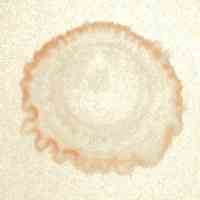 Water stains are usually caused by a plumbing leak, roof leak, or other plumbing problem from the level above. Before you try to fix the stain, make sure that whatever caused the water leak is fixed completely.
Water stains are usually caused by a plumbing leak, roof leak, or other plumbing problem from the level above. Before you try to fix the stain, make sure that whatever caused the water leak is fixed completely.
If the tile can be removed, it should be so you can inspect damage on the backside of the tile. Depending on what the backing material is, you might want to clean the damage or apply a sealer to avoid mold.
If the surface of the damaged ceiling tile is porous or painted:
- First try a dry sponge to remove the stain.
- If this doesn’t work on a porous tile, you might have to replace the tile.
If a water or other tough stain remains after trying the tips above, you will have to repaint the surface of painted tiles.
But before you paint, you should use a good sealer. This will stop the stain from bleeding through the fresh coat of paint. Using a quality sealer will eliminate not only the stain, but if there is any odor associated with the stain such as mildew.
Heavy Duty Stain Removal If All Else Fails
If you decide to replace the tile, you might as well try a harsher cleaning solution to see if it helps with the stain:
In a spray bottle, mix a solution containing:
- 1/4 cup bleach
- 1 quart of water
- Spray the surface with this solution. Do not saturate the area and take to care not to get the bleach solution on anything else.
- Let the area dry and see if the stain is gone. You may need to do more than one application.
- If this solution seems to have worked on the stain, then if at all possible, rinse the ceiling tile because bleach is corrosive and will cause further damage to the tile.
This solution can also be used on painted ceiling tiles, but caution should be used as it might ruin the finish of tiles painted with flat latex paint. Always test in an inconspicuous place first.
Enjoy Your Clean Ceiling Tile
Cleaning my ceiling tiles is an added chore on top of my already monstrous to-do list…but, I really don’t mind because I’m in love with how they make my home look (especially when they’re well kept).
If you follow my advice, you’ll be just as satisfied as I am with the results. All you will need is the the help of your trusty ladder now that you have the knowledge to dust, clean and remove any stains on all types of ceilings tiles in your home.
So good luck, happy cleaning and enjoy your beautiful ceiling tiles!

